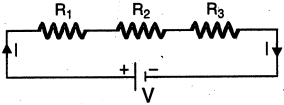Derive the relation $R=R_{1}+R_{2}+R_{3}$ when three resistors $R_{1}, R_{2}$ and $R_{3}$ are connected in series in an electric circuit.
Derive the relation $R=R_{1}+R_{2}+R_{3}$ when three resistors $R_{1}, R_{2}$ and $R_{3}$ are connected in series in an electric circuit.
Consider three resistors of resistances $R _{1}, R _{2}$ and $R _{3}$ connected in series to a cell of potential $V$ as shown in figure. Since the three resistors are connected in series, therefore, the current I through each of them is same.
Then by $Ohm's$ law, the potential drop across each resistor is given by
$V _{1}= IR _{1}, V _{2}= IR _{2}$ and $V _{3}= IR _{3}$
Since $V$ is the total potential in the circuit, therefore, by conservation of energy, we have
$V = V _{1}+ V _{2}+ V _{3}$ $...(1)$
Substituting for $V _{1}, V _{2}$ and $V _{3}$ in equation $(1),$ we have
$V = IR _{1}+ IR _{2}+ IR _{3}$ $....(2)$
If $R_{S}$ is the equivalent resistance of the series combination, then by Ohm's law, we have
$V = IR _{ S }$ $....(3)$
Therefore, from equations $(2)$ and $(3),$ we have
$IR _{ S }= IR _{1}+ IR _{2}+ IR _{3}$
Hence, $R_{S}=R_{1}+R_{2}+R_{3}$ $....(4)$
Thus, in series combination, the equivalent resistance is the sum of the individual resistances.

Similar Questions
$(a)$ Nichrome wire of length $L^{\prime}$ and radius ${ }^{\prime} R^{\prime}$ has resistance of $10\, \Omega$. How would the resistance of the wire change when
$(i)$ only length of the wire is doubled ?
$(ii)$ only diameter of the wire is doubled ? Justify your answer.
$(b)$ Why element of electrical heating devices are made$-$up of alloys ?
$(a)$ Nichrome wire of length $L^{\prime}$ and radius ${ }^{\prime} R^{\prime}$ has resistance of $10\, \Omega$. How would the resistance of the wire change when
$(i)$ only length of the wire is doubled ?
$(ii)$ only diameter of the wire is doubled ? Justify your answer.
$(b)$ Why element of electrical heating devices are made$-$up of alloys ?
A wire of resistance of $10\, ohm$ is bent in the form of a closed circle. What is the effective resistance between the two points at the ends of any diameter of this circle ?
A wire of resistance of $10\, ohm$ is bent in the form of a closed circle. What is the effective resistance between the two points at the ends of any diameter of this circle ?
In a household electric circuit different appliances are connected in parallel to one another. Give two reasons for this. An electrician puts a fuse of rating $5 \,A$ in that part of domestic electrical circuit in which an electrical heater of rating $1.5\, kW , 220 \,V$ is operating. What is likely to happen in this case and why ? What change, if any, needs to be made ?
In a household electric circuit different appliances are connected in parallel to one another. Give two reasons for this. An electrician puts a fuse of rating $5 \,A$ in that part of domestic electrical circuit in which an electrical heater of rating $1.5\, kW , 220 \,V$ is operating. What is likely to happen in this case and why ? What change, if any, needs to be made ?
The $V -I$ graph for series and parallel combination of two metallic resistors is as shown in the figure. Which graph represents parallel combination? Justify your answer.
The $V -I$ graph for series and parallel combination of two metallic resistors is as shown in the figure. Which graph represents parallel combination? Justify your answer.
The unit of electric potential difference is $.....$
The unit of electric potential difference is $.....$


